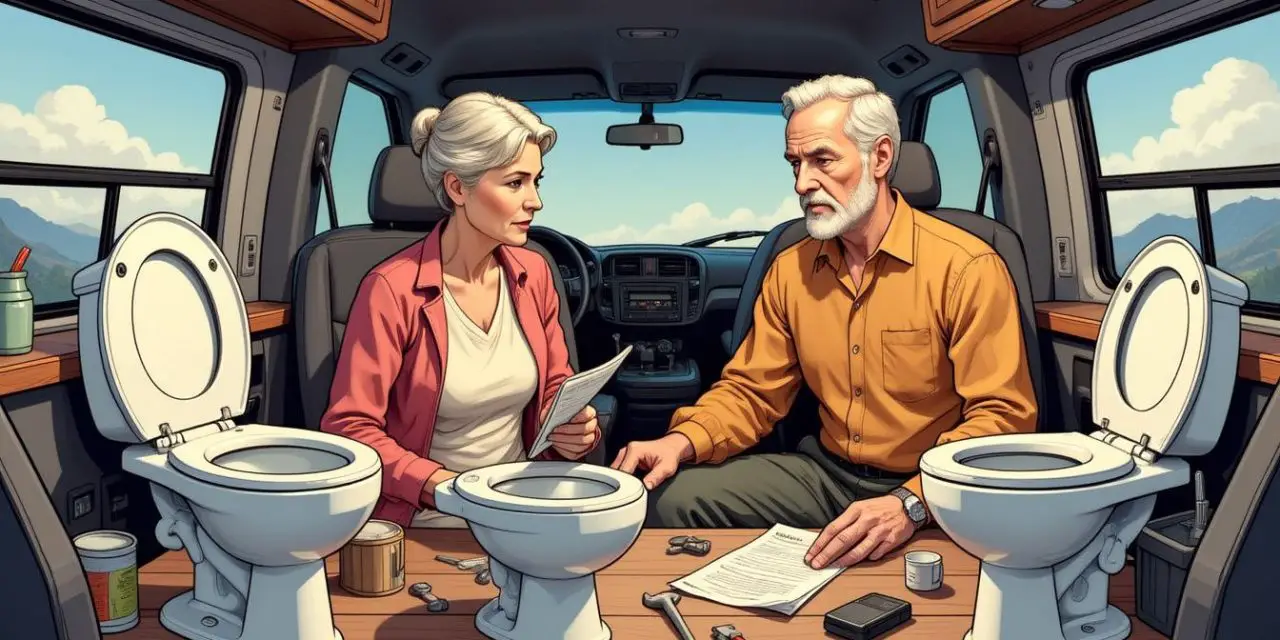Would you like to save this article?
Finding the right RV toilet can be confusing, especially if you’re unsure about compatibility. Not all RV toilets are universal, and choosing the wrong one could lead to messy problems.
This guide will help you understand the basics of RV toilet types, features, and what works best for your camper or motorhome. Stick around; you don’t want to miss this!
Key Takeaways
- RV toilets are not universal. They vary in size, height, mounting patterns, and plumbing needs. Always measure your space before buying.
- Gravity flush toilets need steady water flow, while macerating ones use blades to grind waste but require power. Composting toilets work without water or black tanks.
- Popular models like the Dometic 320 fit standard 11-inch rough-ins, while Thetford Aqua-Magic Residence suits smaller 9.5-inch setups.
- Regular cleaning with RV-safe cleaners and seal checks prevents leaks and odors. Avoid harsh chemicals like bleach.
- Install by aligning the toilet properly over the flange bolts and checking hoses for leaks after securing connections tightly.
Are RV Toilets Universal?
RV toilets aren’t one-size-fits-all, and compatibility depends on several factors. Picking the wrong type can lead to leaks or frustration down the road.
Understanding Compatibility
Not all RV toilets fit every motorhome or travel trailer. They vary in size, height, and mounting styles. Some models might have a 3-inch hole for the flange, while others differ slightly.
You must measure your space carefully before making a choice.
Compatibility depends on plumbing connections and water supply needs too. A toilet designed for late-model Airstreams may not work in older campers. Always check rough-in measurements and ensure the model fits your setup properly to avoid frustration later.
Common Misconceptions About RV Toilets
Many people think all RV toilets are the same. This isn’t true. Sizes, mounting patterns, and plumbing connections vary. A toilet from a camper may not fit in a bus conversion or Class A motorhome.
Some assume household waste systems work the same as RV black tanks, but they don’t. Household toilets connect to city sewage; RVs rely on compact black water tanks for holding waste.
Some also believe composting toilets need no care at all. They do require coconut fiber or similar materials to function properly. Another myth is that portable chemical toilets always smell bad, which isn’t accurate with proper cleaning and maintenance.
Compatibility changes based on your specific setup, so never assume one-size-fits-all solutions for campsites or campgrounds!
Factors That Affect RV Toilet Compatibility
Not all RV toilets fit every setup. Small details like size and hookups can make or break the match.
Mounting Patterns
RV toilets are not one-size-fits-all. Different models have specific mounting patterns, usually tied to the floor flange location. Some toilets require a four-bolt mount, while others use a two-bolt style.
You need to check your RV’s existing setup before buying a replacement.
Popular options like the Dometic 320 or Thetford Aqua-Magic Style Plus often follow standard mounting styles but still demand careful measurement. If your toilet doesn’t align properly, leaks or stability issues can arise.
Always match your toilet type with the flange pattern for smooth installation and fewer problems down the road!
Rough-In Measurements
The rough-in measurement is key to picking a compatible toilet. It’s the distance from the wall to the center of your toilet flange. Common sizes include 11 inches and 9.5 inches.
For example, Dometic 320 models fit an 11-inch rough-in, while Thetford Aqua-Magic Residence works with a 9.5-inch one.
Measure carefully before replacing your RV toilet. A mismatch can lead to installation headaches or return trips to the store!
Plumbing Connections
Plumbing connections in an RV toilet setup can be tricky but manageable. The hose connects the toilet to the black water tank. It must seal tightly to avoid leaks or smells. Reattaching this hose is a key step during installation.
Align it carefully and secure it with clamps or connectors.
Check for leaks after turning on the water supply. A dripping connection could damage your motorhome flooring over time. If installing a new system, always match fittings to your existing plumbing pattern for smooth operation.
Next up, review water supply needs, as they play an important role in compatibility!
Water Supply Requirements
RV toilets need a reliable water source to work well. Gravity flush toilets depend on a steady flow of water to push waste into the black tank below. Without enough water, clogs can form, and odors may linger.
Macerating flush toilets also require some water but use less compared to gravity models. Their motorized blades grind waste into smaller pieces, reducing blockages while using minimal plumbing connections.
Make sure your RV’s plumbing system supplies consistent pressure for smooth operation.
Types of RV Toilets
RV toilets come in all shapes and sizes, offering different features to match your travel needs—so let’s explore the options!
Gravity Flush Toilets
Gravity flush toilets work like traditional home toilets. They rely on gravity to move waste into the black water tank below. This design is simple and dependable, needing little upkeep compared to other options.
You’ll need a steady water supply for proper flushing. These models can also be heavy, making them less suitable for smaller motorhomes or travel trailers. Limited compatibility with certain RVs is another drawback.
If your setup supports it though, this option offers hassle-free operation with no chemicals needed.
Curious about how macerating toilets compare? Keep reading!
Macerating Toilets
Macerating toilets grind waste into a fine slurry. This allows you to pump it through smaller pipes and longer distances. They work well in tight RV spaces where plumbing runs can be tricky.
These toilets use electricity, so you’ll need a steady power source for them to function.
They are efficient but require more care than gravity flush systems. Regular cleaning is key since clogs can happen if foreign objects enter the blades. These models also consume more energy, making them less ideal for boondocking or off-grid camping with limited power access.
Composting Toilets
Composting toilets work without a black water tank. They break down waste into compost using natural processes. These toilets are eco-friendly and use little to no water, making them perfect for dry camping or off-grid adventures.
Instead of flushing into a sewer or tank, waste is collected in separate chambers where it decomposes.
Maintenance can feel like a chore but becomes simple with practice. You’ll need to empty the solid compartment regularly and manage odor by adding materials like sawdust or coconut coir.
Composting units cost more upfront compared to standard RV toilets, but they save on long-term disposal fees.
Portable Toilets
Portable toilets are simple and easy to move, making them a solid choice for RVs. These toilets don’t need plumbing connections like other options. You can place one anywhere in your RV or even outside if needed.
Their main drawback is their limited capacity; frequent emptying becomes necessary.
They operate by storing waste in a small holding tank. Empty this tank at proper disposal sites to keep things hygienic. While they aren’t the most comfortable option, they are lightweight and affordable compared to gravity flush models or cassette toilets.
They’re great for short trips or as backup options!
Key Features to Consider When Choosing an RV Toilet
Picking the right RV toilet isn’t just about getting one that fits, it’s about what works best for you. Small details like material and shape can make or break your bathroom experience on the road.
Bowl Material
Plastic bowls are light and budget-friendly. They work well for smaller RVs or ones with weight limits. The downside? They can scratch easily and may hold onto odors over time.
Ceramic bowls feel sturdy and last longer. They resist scratches and block odors better than plastic. Though heavier, they give your restroom a more durable and refined look. If you want something tough but low-maintenance, ceramic is worth the extra weight.
Seat Height
A comfortable seat height is key for an enjoyable RV toilet experience. Most people prefer a height of 18 inches or more, as it’s easier on your knees and back. The Dometic 320 Series hits this sweet spot with its 18-inch design, offering better comfort compared to shorter toilets.
Choosing the right seat height also affects how accessible the toilet feels in tight spaces. Taller seats can make getting up less of a struggle, especially for older adults. If you’re considering an RV toilet replacement, look out for models that meet this standard.
Bowl Shape
Elongated bowls offer more comfort. They ensure better hygiene, making them ideal for frequent use. These are popular in larger RVs with extra space.
Round bowls save space, making them perfect for tight areas in smaller campers. If your RV has a compact bathroom, a round bowl may be the most suitable choice. Consider the size of your black tank and toilet replacement requirements before deciding on one.
Flush Mechanism Options
A good flush system can make or break your RV toilet experience. Foot pedals are common in traditional RV toilets, letting you control the flush water flow with ease. These pedals help save water, which is great for those who want to stretch their black tank use.
Electric push-button models, like the Dometic MasterFlush 8700 Series, bring a touch of modern convenience. They’re simple to use and add a sleek feel to your setup. Whether you choose manual or electric options often depends on what matches your needs and plumbing setup best.
Popular RV Toilet Brands and Models
Picking the right RV toilet can feel like finding a needle in a haystack. Different brands offer various perks, making it easier to fit your needs and setup.
Dometic 320 Series RV Toilet
The Dometic 320 Series RV Toilet is a solid choice for comfort. It has an 18-inch height, making it feel like a home toilet. The ceramic bowl adds durability and makes cleaning easier.
Its elongated shape gives extra room, so sitting feels more natural.
This model uses a pressurized rim flush that keeps the bowl spotless with every use. A foot pedal simplifies flushing without touching anything by hand. Weighing 37 lbs, it’s easy to handle during installation or replacement in your RV bathroom.
Its size fits an 11-inch rough-in, which matches most modern setups.
Thetford Aqua-Magic Style Plus RV Toilet
The Thetford Aqua-Magic Style Plus gives you a residential-like feel in your RV. It stands at 17.5 inches tall, offering comfort similar to home toilets. Made of ceramic, it feels durable and looks sleek in any setup.
With an 11-inch rough-in, installation is straightforward for most RVs. Weighing only 45 pounds, moving or replacing this toilet isn’t a hassle. Its efficient flush system helps save water while keeping the black tank cleaner.
This model focuses on both comfort and practicality—two things every traveler needs!
Dometic 310 Series RV Toilet
The Dometic 310 Series RV Toilet combines quality and simplicity. Its high-quality ceramic bowl adds durability without extra weight, as it only weighs 23 lbs. With a round shape and standard 18-inch height, it works well for most RV bathrooms while still saving space.
Its reliable flush mechanism makes waste disposal easy and efficient. The toilet’s rough-in measurement is just 10 inches, which helps with easier installation in tighter spots. If you’re considering an upgrade or RV toilet replacement, this model checks many boxes for comfort, style, and practicality.
Thetford Aqua-Magic Residence RV Toilet
Moving from the Dometic 310 Series, the Thetford Aqua-Magic Residence RV Toilet brings lightweight comfort to your RV. It’s made of plastic and weighs just 13 lbs, making it easy to handle during installation or replacement.
This model has an elongated bowl design for added ease and comes with a seat height of 18 inches, which feels more like a household toilet. Its rough-in measurement is 9.5 inches, so it fits compact spaces often found in RVs.
If you want something practical yet comfortable for long adventures, this option works well without adding much weight to your setup!
How to Replace or Install an RV Toilet
Swapping out your RV toilet is easier than you think, with the right tools and a step-by-step guide to keep things simple.
Tools You’ll Need
You’ll need a new RV toilet suited to your setup and an installation kit. Grab a screwdriver, wrench, and some old rags or towels for cleanup. Lay down newspapers to keep the area tidy.
A few hours is plenty of time for this job. Be ready with gloves in case things get messy around your black water tank connection. These tools make the process simple and safe while keeping your hands clean during toilet replacement!
Step-by-Step Installation Guide
Installing an RV toilet may seem tricky, but it’s not. Follow these steps, and you’ll have it done in no time.
- Turn off the water pump to stop the water flow. Flush the old toilet to drain any remaining water.
- Remove the nuts and bolts holding the toilet in place. Use a wrench if they’re tight or rusty.
- Disconnect the hose attached to the back of the toilet. Be ready for possible drips by placing a rag or small bucket nearby.
- Pull out the old toilet carefully. Lift straight up to avoid damaging plumbing connections or scraping nearby surfaces.
- Check your black tank opening before adding anything new. Clean away old wax or debris stuck around it.
- Replace the existing gasket at the base with a fresh one. A new gasket helps prevent leaks and odors later.
- Align your new RV toilet over the bolt holes on the floor flange carefully. Lower it slowly into position for a good fit.
- Tighten all bolts evenly by hand first, then use tools lightly as needed to secure stability without cracking anything.
- Reattach hoses firmly at their connection points on both ends, ensuring no cross-threading occurs during this step.
- Test for leaks by turning on your water pump again briefly while inspecting connections closely for drips or dampness.
- Check that everything feels stable after installation by gently pushing or sitting on it without wobbles or shifts.
Ready for maintenance tips? Let’s keep that new toilet working smoothly!
Tips to Ensure Your RV Toilet Lasts Longer
Keep it clean, check for leaks, and handle with care—your RV toilet will thank you!
Proper Cleaning Techniques
Use RV-specific cleaning products to protect your toilet’s parts. Avoid harsh chemicals like bleach, as they can damage seals and components. A gentle cleaner made for RV toilets works best.
Spray or wipe the bowl, seat, and lid thoroughly.
Flush black tanks regularly to prevent buildup and odors. Check for clogs in pipes or vents while cleaning. Replace any worn-out seals that could lead to leaks over time. Regular care keeps your toilet fresh and functional longer!
Regular Maintenance Checks
Check your RV toilet seals often. Lubricate them to keep leaks and bad smells away. Damaged seals lead to odors or water leaks, so replace worn ones quickly.
Inspect the plumbing connections for cracks or loose fittings. Tighten or fix any issues before they get worse. Regular checks can save you from costly repairs down the road!
Conclusion
RV toilets are not one-size-fits-all, but finding the right fit isn’t rocket science. Focus on your RV’s needs, like size, plumbing, and mounting style. Explore different types to find what works best for your setup.
With the right pick and care, you’ll have a comfy and reliable toilet for all your adventures!
FAQs
1. Are all RV toilets the same size?
No, RV toilets are not universal in size or design. Some models need specific fittings, and others may require a toilet riser for better height compatibility during installation.
2. Can I replace my RV toilet with any brand?
Not always. Different RV toilet brands have unique designs that might not fit every setup. Check your black water tank connection and mounting points before choosing an RV toilet replacement.
3. What’s the difference between a cassette toilet and a portable toilet?
A cassette toilet has a small built-in black tank you can remove to empty, while a portable toilet is entirely separate from your RV’s system and easier to move around.
4. Do I need special tools for installing an RV toilet?
Usually, basic tools like wrenches are enough for most installations, but it depends on the model of your current unit and how it connects to the black tank or grey water system. Always check instructions first!





